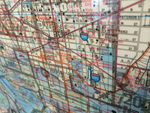In the original Disneyland, restaurants were operated by outside lessees, but today, Disney controls everything inside the parks except for Starbucks (each park has one). That hasn’t done much for the quality of the food (prepare for memories of your grade-school cafeteria), but at least the math is easy. The cheapest combo meals are always from counter-service restaurants (called Quick Service in Disney-speak), where adults usually pay $11 to $16, including a side but not a drink—the combo is called a “meal.” Kids’ meals (a main dish; milk, juice, water, or soda; and a choice of two items including grapes, carrot sticks, applesauce, a cookie, or fries) always cost $7–$8 at Quick Service locations.
If you want to sit down for a waiter-service meal—character meals are always in “table-service” restaurants—adults pay in the upper teens for a lunch entree and usually over $21 a plate at dinner, before gratuity or drinks, and kids’ meals are about half as much. The Disney World app lists restaurant menus, but sometimes not the prices—if you want to see the prices of any quick-service restaurant, though, you can hit the desktop Disney World site or go through the motions of a Mobile Order (during park operating hours only) to check them out.
Outside of the pandemic, Disney aggressively sells a Disney Dining Plan that takes away the need to pay a bill after each meal, but which comes with a lot of rules and requires a lot of advance reservations.
No longer can you simply stroll into any restaurant that catches your eye and enjoy a meal. Oversubscription to the Dining Plan (and later, capacity restrictions due to coronavirus) spoiled that for everyone. For table-service meals, always make an advance dining reservation (407/939-3463)—you’ll hear them called “ADR”s—or you’re certain to be turned away. Menus and prices are listed on the Disney World app, where you can also reserve. If a restaurant is booked, try again 24 hours ahead, when people dump unwanted reservations before a $10 no-show penalty is assessed.
Semi-healthy options are possible on even the lowest food budget: Disney limits saturated fat and added sugar to 10 percent of a counter-service dish’s calories; no more than 30 percent of a meal’s calories or 35 percent of a snack’s calories come from fat; and juice drinks have no added sugar. Trans fats are out. One way Disney seems to have accomplished this is by reducing serving sizes—you won’t feel stuffed.
Kids’ meals come with carrots, applesauce, or grapes instead of fries, and with low-fat milk, water, or 100% fruit juice instead of soda. (Fries and Coke are still available by request—they know kids are still on vacation.) Plastic straws are history here. If paper ones bug you, consider bringing your own reusable straw.
It will always be cheaper to drive off property to feed your family, but particularly at the Magic Kingdom, that’s not always possible or desirable. Consult the list of restaurants located outside the theme park gates, found in the Orlando section.
Note: This information was accurate when it was published, but can change without notice. Please be sure to confirm all rates and details directly with the companies in question before planning your trip.








